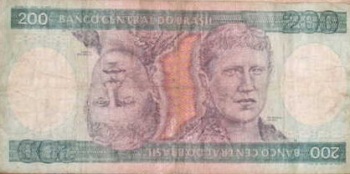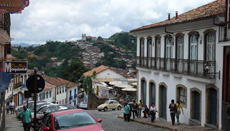
|
|
The Palace |
A great idea – Hyperinflation – The pantry – A quintillion – Spending quickly – Deep sea fish
There are many countries in this world, one hundred and ninety five at last count, all using paper currency to conduct business transactions. In fact the idea of paper money is such a good one most people in living memory don’t recall using any other form of currency to transact business. Having money is a good thing, having a lot of money is a great thing, but having too much is another matter entirely.
It is amazing that hyperinflation has been relatively rare in history. I had naively assumed that hyperinflation came about when the government let loose the printing presses and there is simply too much money. But it turns out that the causes of hyperinflation are more complicated and related to make-your-head-spin aspects of a countries’ monetary policy like the velocity of money. In this post I will discuss the history of hyperinflation in Brazil and how my friend Dalva’s family and other ordinary folk dealt with it.

|
|
Biscuits? |
The small room was crammed full of food and household necessities. More than a pantry, it was a Barry Bonds of pantries on steroids, a veritable mini-market unto itself. There was soap, cooking oil, beans, rice, salt, and a myriad other goods that we need for daily life. The interesting thing about this room was that it was not unique – homes all over Brazil sprouted these little rooms because the money was useless and everyone got rid of it as quickly as possible. With the rapidly devaluating money people bought the goods they needed and hoarded them.
A visit to the museum of money (Casa dos Contos) in Ouro Preto seemed harmless enough – but walking through the rooms an astounding story presented itself. Rather uneventfully, between 1690-1942 Brazilians used the Real as their money, until it was replaced by the Cruzeiro (cross, as in cross off the last three zeroes) at a rate of 1,000 to 1. Then the story got interesting – in rapid succession came the Cruzeiro Novo, Cruzado, Cruzado Novo, cruzeiro (again), and cruzeiro real. All changed hands at 1000 to 1, so one cruziero real was 1,000,000,000,000,000,000 or one quintillion of the old reais!

|
|
Innovative design – no need to arrange face up! |
Once in a while familiar faces looked out at us from the notes, our favorite Brazilian heroes – Santos Dumont, Cândido Rondon, Getúlio Vargas, Juscelino Kubitschek, Adelir de Carli… (Okay, I lied about the last one, but he so deserves to be on currency!) The government must have worried about running out of important people to put on bills! Innovative designs, overprints, and vibrant colors created a bewildering array of notes – it is a tribute to the Brazilians that they kept them straight.

|
|
Dalva’s mom |
As soon as Dalva’s mother got paid she rushed to the Cotripal supermarket and bought as much stuff as she could. In an enduring image of this period Cotripal would be filled with clerks with pricing machines, changing the prices of everything. Salaries were not denominated in the prevalent currency but a base + index method that took inflation into account. Looking at it from the outside it sounds a little surreal but for everyday Brazilians living within this universe it seemed completely normal. So normal that…
Some people thrived in this environment, incredible as that may seem. The reason why hyperinflation is hard to stop once it gets started is that there is a vicious feedback loop, things cost more so money supply has to be increased, which in turn causes the prices to go up, so more money is required, etc. In order to convince people to put their money in banks they had to pay huge interest rates, so high that some people were able to live off the interest. Even though the prices went up their incomes went up faster, down to the point that little capital was needed to generate great income. When the hyperinflation finally ended they became impoverished. Since they had been expecting high interest rates they had little capital when the economy returned to normal. They were like deep sea fishes that turn their insides out when brought up to the surface from the crushing depths.

|
|
Business as usual |
The locomotive of hyperinflation had such inertia that it was very difficult to stop and plan after plan failed. Finally the Real plan, based on sound fundamental policy like, don’t spend money that you don’t have and don’t promise the people what you can’t give won out. But the toughest part was getting the people to not expect hyperinflation, because after so many years it was too weird living without it…
The good ‘ol USA is cranking up the presses here. One wonders what happens to inflation after the banking bailout funds hit the street($1.2 Trillion estimate) and the Stimulus ($785 Billion at last count).
I hope that some people a lot smarter than I are thinking about the “velocity of money” and other money shit. Oh Dear!